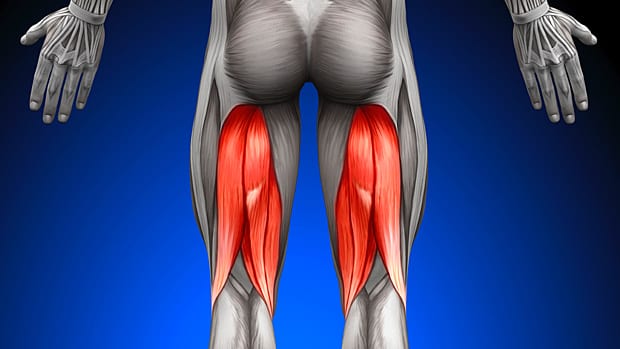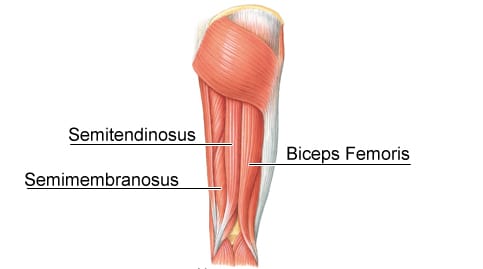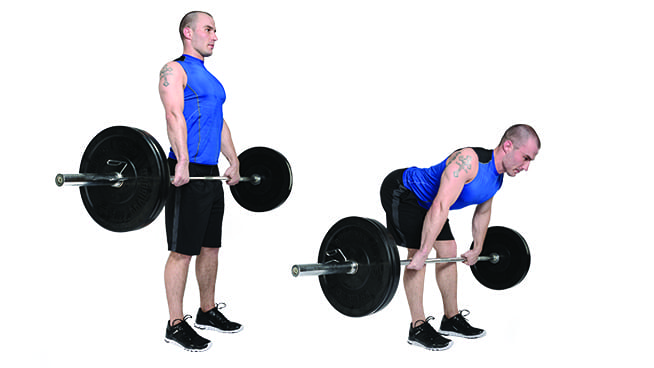Everything you need to know to get bigger and stronger hamstrings…
16/12/2020
What do you know about hamstring training?
Here’s a few quick(ish) fire facts for you to take along to your next leg session…
Firstly, do you know why we do certain exercises or are you just doing things for the sake of it?
There are certain isolation exercises for the hamstrings but for the most part, lots of leg exercises will bring all of the lower body into play at the same time eg on leg press or squats, the quads, glutes and adductor/abductor can also get used…
So we need to know what we can do to target the hamstrings more if this is a weaker area for you.
In short, the hamstring is made up of three parts:
Hamstring Anatomy

#1 Biceps femoris (the largest part) which has two heads just like the arm bicep on the outside of the thigh.
#2 Semitendinosus which is on the inside of the thigh.
#3 Semimembranosus which is also more inner, but lies mostly underneath the semitendinosus.
The hamstring is polyarticular which means that it crosses two joints, these being the hip and the knee, so we need to make sure they get worked at their optimal length….in other words make sure you get a full stretch and contraction with each rep.
Great Exercises for the hamstrings…
- Stiff leg Deadlift (compound)
- Seated Leg Curl (isolation)
- Lying Leg Curl (isolation)
- Standing Leg Curl (isolation)
There are lots of exercises you can do to build bigger hamstrings – It’s about choosing the ones that are right for you and your body mechanics. If in doubt reach out and hire a coach to help you.
4 Hamstring Exercises With Video Demonstrations…
Here are 4 of my favourite hamstring exercises, I will include these into my weekly routine.
Barbell Romanian Deadlift:
Dumbbell Romanian Deadlift:
Dumbbell Hamstring Curl:
Single Leg Hamstring Deadlift:
Hamstring training tips…

Get more out of your leg press and squat variation by adding bands to make sure that at the top of the movement where the resistance would usually start to decrease, it increases meaning that the hamstrings will have to keep working at their optimal length.
Supersets: are a fantastic way to hit hamstrings by combining movements like so:
Pre exhaustion: an isolation exercise followed straight away by a compound, so leg curls followed by leg press.
Post exhaustion: a compound movement followed by an isolation, so hack squat followed by seated leg curl.
The hamstrings react very well to forced negatives, if you have a workout partner get them to gently push against safely (whilst you try and resist) the negative portion of certain movements like leg curls, adductor/abductor.
For larger compound movements (or for any exercise if you train alone) you can slow down the negative portion of the rep for a few reps at the end of your set.
Increase frequency
If you have underdeveloped hamstrings then it may be a good idea to add a second session during the week away from your main leg workout, focussing on hamstrings. This will also allow for better motor recruitment if you struggle to feel them work.
Unilateral work (single leg) is great if you have an imbalance between both sides and actually, you will sometimes find that you can feel them work better by doing one side at a time.
Some extra hamstring training tips include…
Work the hamstrings at different lengths…
- Some exercises work the hamstrings at the optimal length: seated leg curls & sliding lunges.
- Some stretch the muscle to the extreme: stiff leg deadlift & good mornings.
- Some work at a shortened position: standing leg curls & lying dumbell curls on a straight bench.
Work the hamstrings at different angles…
- Movements that bring the feet towards the glutes: leg curls.
- Movements that lift the torso: various deadlift and good mornings.
- Movements which contract the upper part whilst stretching the lower part: sliding lunges.
- Movements which work the above movement in reverse: seated leg curls (leaning forward at the top of the movement).
Work the hamstrings with different feet positions…
- Turning your feet out will concentrate more on the outer biceps femoris
- Turning the feet in will focus more on the two semis (in the inner part)
If you are adding a second session for hamstrings do different things in each session, if you don’t need to add a second session…vary the different angles etc within the one workout.
Stick to something for around 6-8 weeks before changing some bits around.
A few tips for when working on machines…
- Don’t over arch your back on lying leg curls.
- Keep the torso as upright as possible when doing standing hamstring curls.
- Keep yourself pressed into the seat when doing seated hamstring curls.
Squats do work the hamstrings but the ability to feel and recruit them specifically can be difficult. This is why isolation work is indispensable if you have not yet learned to feel your hamstrings work during compound movements.
Exercises which work the whole leg (but these variation will help to hit more hamstrings)…
- Feet high and wide on leg press
- Smith machine duck squats
- Walking lunges with a long stride
- Sumo deadlift
- Feet slightly higher and wider on hack squat
- Reverse hack squat
Like with anything, the only way to find out what works best for you is to experiment!
Nothing looks better than hanging’ hamstrings so give some of these a go and let me know if they make a difference.
Thanks for reading,
If you would like more training tips please check out my blog (there are over 1,000 articles on my site). Also, If you liked this article you may also want to check out the following:
- CHEST AND TRICEP WORKOUT FOR SERIOUS MUSCLE GAINS
- 13 LANDMINE EXERCISES FOR BUILDING STRENGTH & MUSCLE
- 7 OF THE BEST TRX EXERCISES FOR BEGINNERS + FREE TRX WORKOUT PROGRAM
- RESISTANCE BAND WORKOUT |8 WEEK PROGRAM TO TRY AT HOME

Nick Screeton – please contact Nick here if you have any questions relating to your personal health and fitness goals.